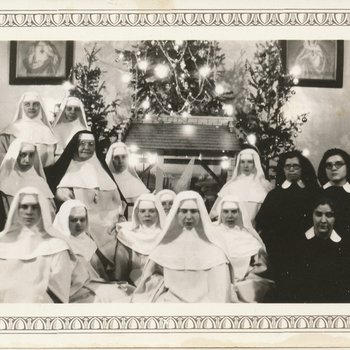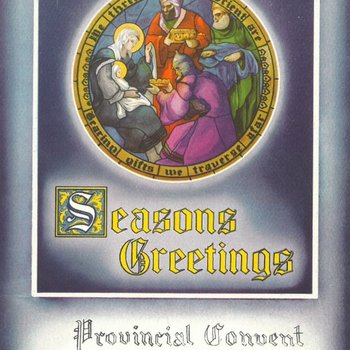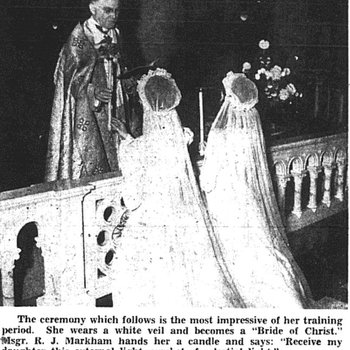Remembering Girls' Town of America, Cincinnati, Ohio
Life at Carthage: Rituals, Observances, Routines
First-person account of life at Carthage from Sister Magdalen Pancratius, recorded in 1951
Read the sisters' Christmas letter, 1950
Living at the Carthage site were four groups:
- The Sisters of the Good Shepherd, vowed religious referred to as "Mothers," along with postulants and novices who aspired to become Sisters.
- The Magdalens, a contemplative community supervised by the Sisters of the Good Shepherd. Magdalens were not able to become Good Shepherd Sisters. They made annual, temporary vows over a 10 year period, after which they could make make perpetual vows. They were known for fine embroidery, sewing altar linens and vestments, and making altar breads.
- The "children"--the term used for the girls and women cared for and educated at Our Lady of the Woods. These included
- penitents or the reformatory class, sometimes called "problem" or "delinquent " women and girls, or "fallen women and girls," as they were listed in the Benevolent Institutions Censuses of 1904 and 1910 .
- dependents, also known as the preservate or preservation class, sent to the facility due to destitution or unfavorable home conditions.
According to Phillips, "the terms penitent class or preservate class were used routinely in the nineteenth century, but were phased out and finally eliminated during the late 1930s to prevent the girls’ developing a sense of stigma associated with being considered a 'bad girl.'" (p. 139)
The delinquent and dependent classes lived separately. The institution served both black and white girls of both classes; in the early to mid-twentieth century, the races were housed separately and had separate entrances to the Chapel. Photographs from the late 1940's and later show mixed race groups engaging in various activities.
Daily Life and Routine
Though the typical daily activity schedule varied between facilities, the following schedule excerpted from the 1948 Vista Maria Handbook for students in Detroit, Michigan, may have been close to that observed by girls at Carthage.
- 6:00 A.M. Rising
- 6:30 A. M. Mass
- 7:00 A.M. Breakfast
- 7:30 A.M. Duties as assigned and recreation
- 8:30 to 11:45 A.M. Academic subjects
- 12:00 to 1:00 P.M. Lunch and recreation
- 1:00 to 4:00 P.M. Vocational subjects (referred to as “employments”)
- 4:00 to 5:30 P.M. Recreation (Band practice 4:30 to 5:30 P.M.)
- 6:00 P.M. Dinner
- 8:00 P.M. Study hour
- 9:00 P.M. Bedtime
(cited in Phillips, Education for Girls in the House of the Good Shepherd, 1940-1980, p. 175, note 580, from Handbook in the Sisters of the Good Shepherd Archive)
The girls had age-appropriate housekeeping chores such as laundry and ironing, meal preparation and cooking, gardening, housecleaning, and sewing. (Phillips, p. 134) Like most Good Shepherd schools, the Carthage facility operated a commercial laundry and sewed embroidered clothing to supplement its income. As at other rural institutions, its gardens and small animal farms provided food for the residents. The girls contributed manual labor as part of their re-education process. (Phillips, p. 21) "Commercial laundries in the Good Shepherd schools were progressively closed because the mandatory requirements for school attendance decreased the time available for the girls to work" (Phillips, p. 183) and this appears to have been the case at Carthage, though the date the commercial laundry closed is not known.
Next section: Music, Recreation, Vocational Training












